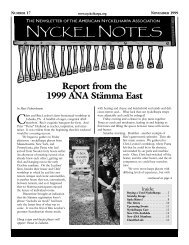Download Number 2 - American Nyckelharpa Association
Download Number 2 - American Nyckelharpa Association
Download Number 2 - American Nyckelharpa Association
You also want an ePaper? Increase the reach of your titles
YUMPU automatically turns print PDFs into web optimized ePapers that Google loves.
Nyckel Notes Oct 1995 8<br />
mentioned in Mel’s article (this issue) and save a few<br />
bucks.<br />
Note #1: Don’t let the colored thread wrapping on<br />
the ball-end of the string pass the bridge (so some of<br />
the vibrating portion of the string has the thread on<br />
it). It will dampen your string, and do bad things to<br />
its sound. Simply make a knot in the string about 2<br />
inches from the ball end, and use that knot as if it<br />
were a ball end (as you tighten the strings, the<br />
tension against the fine-tuner will tighten the knot). If<br />
the ball vibrates and makes a noise, you can cut it off<br />
with wire cutters.<br />
Note #2: Most cello strings are way too long for a<br />
nyckelharpa, and you may be tempted to cut off the<br />
end. This is bad. If you cut past where the colored<br />
thread stops, the string’s outer layer will start to<br />
unwind, and will ruin the string. Easiest is the leave<br />
the excess string attached. Since you can’t wind up<br />
all the excess on the tuning peg, you should leave<br />
enough for 5 or 6 winds, and pull the rest through the<br />
hole in the peg. Then wind it up in a little loop.<br />
Alternatively, you can get out your own thread and<br />
hot wax and make your own windings in the right<br />
place, and then cut off the excess. Or use superglue<br />
on all sides of about 2 inches of string then cut<br />
off the excess. But really, it’s easiest to wind up the<br />
excess in a little loop.<br />
Just as we go to press, I heard that Prim has started<br />
making strings specifically for the nyckelharpa,<br />
including a wound A-string. I think the other 3 strings<br />
are essentially cello strings that have been<br />
manufactured shorter, to fit the nyckelharpa. I’ll look<br />
into it during my upcoming trip to Sweden (for my<br />
Mormor’s 90th birthday party!) and get back to you.<br />
How Often to Change Strings<br />
How long should you go between changing strings?<br />
It depends on how much you play and how often you<br />
can afford it. On my fiddle, I change strings three or<br />
four times a year. On my nyckelharpa, I change the<br />
playing strings about once a year, except for the A-<br />
string which is cheap enough to change three or four<br />
times a year. But then again, I play a lot.<br />
Strings wear out because the rosin is hard enough to<br />
slowly wear away metal. Microscopically, the top of<br />
the string gets flat, and the bow can’t grab that as<br />
well as a round string and tends to just slide over it<br />
without exciting it to vibration. Also, on wound<br />
strings rosin dust gets down in between the windings<br />
and starts to cut at the windings and the core.<br />
Plus, old strings sound bad.<br />
If you’re resonably careful about wiping away excess<br />
rosin dust from all your strings, your resonance<br />
strings should last several years. Strings do sound<br />
brighter when they’re brand new, so you can brighten<br />
your sound a little by replacing them.<br />
String Report<br />
If you’ve found a particularly good (or bad) brand of<br />
strings for use on the nyckelharpa, drop me or Mel a<br />
line so we can recommend (or warn against) them.<br />
My address is in the “<strong>American</strong> <strong>Nyckelharpa</strong><br />
<strong>Association</strong> Information” section near the end.<br />
The Resonance (Small) Strings<br />
These are guitar strings too, in two or three gauges.<br />
Some people prefer to have the lowest three notes<br />
be slightly thicker, others prefer all 6 of the lowest<br />
notes be the same gauge.<br />
• The highest 6 strings (D up to G): Any brand<br />
plain guitar strings that’s .014 inches in diameter.<br />
• The middle three strings (B, C, C#): Any<br />
brand wound guitar strings that’s .021 inches in<br />
diameter.<br />
• The lowest three strings (G#, A, Bb): Either<br />
use the same as B, C, C#, or use any brand<br />
wound guitar strings that’s .024 inches in<br />
diameter.<br />
Guitar strings shouldn’t cost you more than a dollar<br />
or two each, and can be found at almost any music<br />
store. Or try the catalogs for even cheaper strings.<br />
A Note to the Editor<br />
Dear Editor,<br />
from Birgitta Wallin<br />
(translated by Bart Brashers)<br />
When I read the editor’s note to Mel Meer’s article<br />
in the last issue of Nyckel Notes (No. 1), I became<br />
very surprised. Hogmark’s claim that there was<br />
some negative tension between Eric Sahlström and<br />
Ceylon Wallin is completely untrue. Just the<br />
opposite, there existed a great respect and<br />
confidence between Eric and Ceylon. Eric’s<br />
daughter, my good friend Sonia Sahlström, has has<br />
confirmed this. Sonia added that of course Eric was<br />
happy to make another nyckelharpa for Ceylon, but<br />
there were so many “in line” who were without a<br />
harpa altogether, and “he who nagged the most got
















